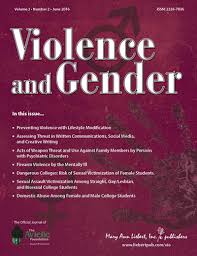 A journal is reviewing a paper about trends in rape at U.S. colleges after the author realized a mistake.
A journal is reviewing a paper about trends in rape at U.S. colleges after the author realized a mistake.
Although the journal Violence and Gender hasn’t issued any editorial notice about the paper, Inside Higher Ed published a correction July 14 to its original news story about the topic.
“Dangerous Colleges: Associations Between School-Level Factors and the Risk of Sexual Victimization of Female Students” found that the risk of rape was higher at large, public institutions, but after the author realized he had made a coding error, he contacted Inside Higher Ed to explain that the risk of rape was higher only at public universities, regardless of their size.
The paper appeared in the June, 2016 issue of the journal; Sophie Mohin, Assistant Managing Editor for publisher Mary Ann Liebert, told us the author alerted the journal to the mistake on July 12:
At present, Editor-in-Chief, Dr. Mary Ellen O’Toole is thoroughly re-reviewing the paper and the reviews to determine the best way forward.
We anticipate publishing a formal correction, but we may consider a retraction if the Editor feels that misconduct occurred in this case. We have yet to determine the most appropriate way to handle the circumstance.
Here’s the correction notice issued by Inside Higher Ed:
An Inside Higher Ed article published on Tuesday — about a study that found the risk of forcible rape was higher at large, public institutions — was incorrect. The author of the study later found a “typo in [his] coding” that led to the erroneous finding. While the author stands by the finding that undergraduate women at public universities are at greater risk of becoming victims of rape than those at private colleges, he said the size of a university had no significant effect on the risk of sexual victimization.
Inside Higher Ed regrets the error.
Author Stephen Cranney of Baylor University told us he noticed the error while “preparing my coding file for posting online.” (An aside: The explanation for what went wrong will likely make the most sense to our readers who are familiar with statistics):
Basically, the original dataset had the natural log for college enrollment figures; to see which functional form fit the data better, I converted the enrollment figures from their log form and ran the models with both of them. Although the results were both significant, the non-log enrollment figures had a better fit so I went with the linear variable.
But then he realized his mistake:
I noticed that I inadvertently used x^e instead of e^x in the conversion. When the corrected linear enrollment figures were used, the result crossed the threshold into insignificance (p=.068).I was in a bind. On one hand, I did not want to change to the natural log of enrollment just to get a significant finding, and thus make me guilty of p-value hacking. On the other hand, I did initially decide to use the linear enrollment figures simply because they (at the time) fit the model better, although both were significant. Additionally the only other paper that has used this data used the log of student enrollment (Adkins et al. 2015 below), so I’d be following precedent for this dataset, plus it seems a reasonable choice given the variation in enrollment size among schools. So I thought it might be sufficient to use the natural log and explicitly note in the ms that the results are sensitive to the functional form of the enrollment figure.
So he contacted the journal and media outlets who had covered the story:
I emailed the editor to let her know and to get her thoughts. So while I think I can make a strong case for an erratum explaining my initial choice, the error, and the change, it’s ultimately her call. I haven’t heard back from her yet, so right now I’m just waiting.
In the meantime, it was getting some media attention so I called up/emailed the reporters and tried to staunch the fire before we got things figured out (hence the notice in the Inside Higher Education article). Also, the President of my University emailed me for a copy of the study earlier (they’re revising their sexual assault prevention policies right now) so I had to let him know as well.
Cranney added that none of the other results about trends in rape at colleges and universities were affected by the mistake.
Hat tip: Michael Balter
Like Retraction Watch? Consider making a tax-deductible contribution to support our growth. You can also follow us on Twitter, like us on Facebook, add us to your RSS reader, sign up on our homepage for an email every time there’s a new post, or subscribe to our new daily digest. Click here to review our Comments Policy. For a sneak peek at what we’re working on, click here.
The research method is flawed from the beginning, if the author does not carefully investigate how rape cases are handled on campuses. The private university I worked for had its own police force on campus — not “security” but the REAL police had a station on campus. Since it was a Christian university, all kinds of crime was covered up in the most “innocent” way: the police would hand over the offenders to the campus admins rather than actually arresting them in many cases. At least two of my female students were raped in the 8 years I taught there, and both of them ended up leaving the school because of the way their cases were handled. When the private school controls the police force, of course more rapes are going to be reported at public schools. Doh.